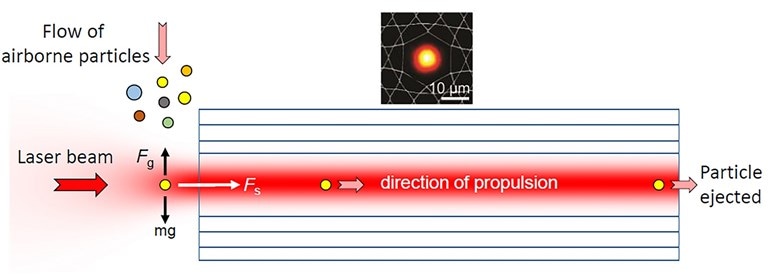Nov 13 2019
An optimized technique for monitoring air pollution could be to continuously monitor both the size and optical properties of individual airborne particles. The technique could be specifically promising to analyze fine particulate matter measuring <2.5 μm (PM2.5), which can cause health problems by reaching deep into the lungs.
 A new approach for particle analysis uses a laser beam to capture airborne particles and propel them through a hollow-core photonic crystal fiber. The particle diameter and refractive index can be retrieved by monitoring changes in fiber transmission. Image Credit: Philip Russell, Max Planck Institute for the Science of Light.
A new approach for particle analysis uses a laser beam to capture airborne particles and propel them through a hollow-core photonic crystal fiber. The particle diameter and refractive index can be retrieved by monitoring changes in fiber transmission. Image Credit: Philip Russell, Max Planck Institute for the Science of Light.
Air pollution has become an essential problem in many countries. Since our setup is very simple and compact, it should be possible to turn it into a table-top device for continuously monitoring airborne PM2.5 in urban areas and industrial sites.
Shangran Xie, Research Team Leader, Max Planck Institute for the Science of Light
Xie belongs to the group of Prof. Philip Russell from the Max Planck Institute for the Science of Light in Germany.
In the Optics Express journal published by The Optical Society (OSA), the team describes the use of optical forces to automatically trap particles in the air and thrust them into a hollow-core fiber for analysis. The technique solves a number of drawbacks of current methods by providing highly reproducible, real-time results and an unrestricted device lifetime.
The most unique feature of our technique is that it can count the number of particles—which is related to the level of pollution—while simultaneously providing detailed real-time information on particle size distribution and chemical dispersion. This additional information could be useful for fast and continuous pollution monitoring in sensitive areas, for example.
Shangran Xie, Research Team Leader, Max Planck Institute for the Science of Light
Capturing Particles with Light
As part of the new analysis technique, airborne particles were captured within a laser beam by optical forces and thrust forward by radiation pressure. The trapping force is sufficiently strong to overcome the gravitational force that acts on extremely small particles like PM2.5. It also automatically aligns the particles with a hollow-core photonic crystal fiber.
These exclusive fibers include a hollow central core surrounded by a glass microstructure that restricts light within the fiber. As soon as the particles are aligned, the laser light thrusts the particle into the fiber, causing the laser light within the fiber to scatter and produce a detectable decrease in the fiber transmission.
The scientists created a new signal processing algorithm to extract useful information from the particle-scattering data in real-time. Once the detection is completed, the particle is just evicted from the fiber without any damage to the device.
The transmission signal from the fiber also lets us measure time-of-flight, which is the time the particle takes to travel through the fiber. The drop in fiber transmission together with the time-of-flight information allow us to unambiguously calculate the particle size and refractive index. The refractive index can assist in identifying the particle material because this optical property is already known for most common pollutants.
Abhinav Sharma, Doctoral Student, Max Planck Institute for the Science of Light
Precision Measurements
The team used polystyrene and silica particles of various sizes to test the technique. It was discovered that the system had the ability to accurately isolate particle types and could measure the 0.99 μm silica particle with a resolution as low as 18 nm.
The researchers intend to test the ability of the system to investigate the particles that are more commonly found in the atmosphere. They also intend to show the potential of the technique to carry out measurements in liquid, which would be helpful for monitoring water pollution.
The researchers have filed a patent on this technique and intend to continue the development of prototype devices, for example, ones that could be applied for monitoring air pollution outside the lab.